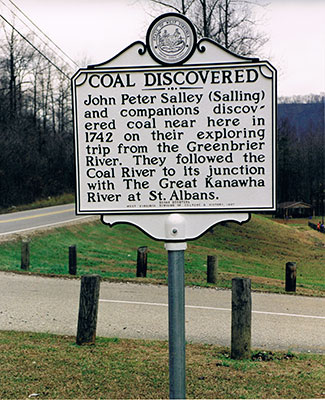The History of Boone County
 Boone County was formed in 1847 from Kanawha, Cabell, and Logan Counties, Virginia. The county was named for Daniel Boone, a noted hunter and explorer, who made his home in the Great Kanawha Valley from 1788 to 1795 although not in the area which later became Boone County. So why name the county for someone who had never lived there?
Boone County was formed in 1847 from Kanawha, Cabell, and Logan Counties, Virginia. The county was named for Daniel Boone, a noted hunter and explorer, who made his home in the Great Kanawha Valley from 1788 to 1795 although not in the area which later became Boone County. So why name the county for someone who had never lived there?
In 1786, Shawnee Indians attacked the home of a young girl named Chloe Flinn. The father was killed. The six year old along with her mother, brother, and sister were taken to Ohio by the Indians. A few months later, Daniel Boone came across the group and traded meat, flour, and whiskey to the Shawnees in exchange for several white prisoners including Chloe. Boone brought the little girl to live with his family in Limestone (now called Maysville), Kentucky. He then located some of Chloe's relatives and brought her to an uncle in the Charleston area. Sixty years later, Chloe Flinn's son, St. Clair Ballard, was a House of Delegates member from Logan County (now Boone) and related that story to the Virginia General Assembly in Richmond. Ballard asked that legislators to name the new western Virginia county in honor of the man who rescued his mother.
Although Boone County was named for the great American frontiersman, it was another explorer, John Peter Salley, who had a more significant impact on what was to become Boone County. In 1742, while on an exploring trip, Salley and companions discovered coal near the present day community of Peytona. The discovery of coal has played a vital role in fueling the steel mills and power plants of the United States, and remains the backbone of Boone County's economy.
In pioneer days, a small log courthouse was constructed when the county seat was known as Ballardsville. That name source was St. Clair Ballard, the Virginia legislator who named the county. Ballardsville was torched by Union soldiers during the Civil War but citizens rebuilt it near the old site. In 1865, a new courthouse was constructed from brick. That structure was condemned in 1913 and the foundation of the present courthouse was begun a year later. The present courthouse, constructed of Indiana limestone, was completed in 1921. The building is impressive and remains the center of community life in the county seat of Madison. The beautiful structure is on the National Register of Historic Places.
On June 20, 1863, when a new state was born out of the Civil War, Boone County Virginia, became Boone County, West Virginia.
In 1906, Madison was incorporated as the county seat. Madison derived its name from Colonel William Madison Peyton, who led the movement for the formation of Boone County. Peyton was instrumental in developing the Coal River Valley. There are three other municipalities in Boone County--Danville, Whitesville, and Sylvester.

